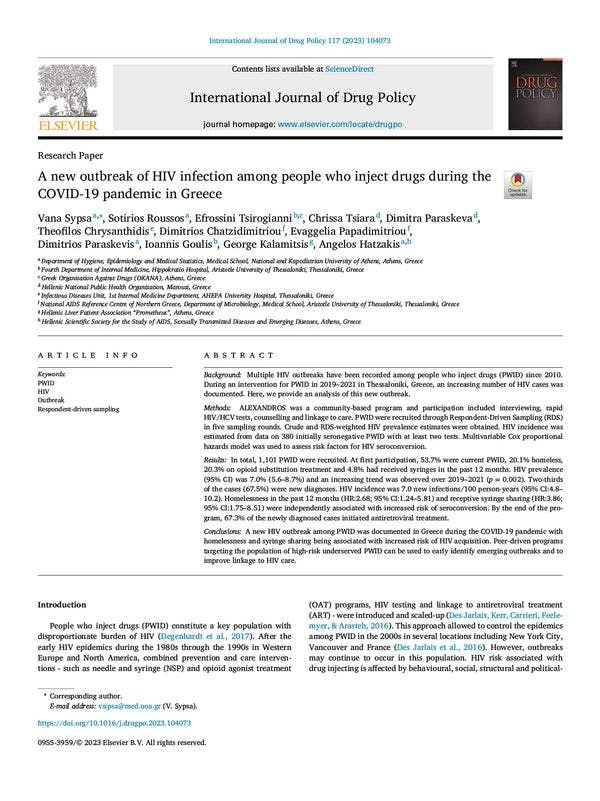Un nuevo brote de infección por VIH entre personas usuarias de drogas inyectables durante la pandemia del COVID-19 en Grecia
Sypsa et al. destacan la eficacia de los programas impulsados por pares para detectar precozmente un brote localizado de VIH y poner en marcha respuestas de salud para mitigarlo. Más información, en inglés, está disponible abajo.
Highlights
- A new HIV outbreak among PWID was identified in Greece during 2019–2021.
- Homelessness and syringe sharing were risk factors of HIV seroconversion.
- A peer-driven seek-test-treat intervention allowed to early identify an emerging HIV outbreak.
- Cases were linked to HIV care and two-thirds initiated ART despite the COVID-19 pandemic.
- This approach could be used as an example of good practice for other settings as well.
Abstract
Background
Multiple HIV outbreaks have been recorded among people who inject drugs (PWID) since 2010. During an intervention for PWID in 2019–2021 in Thessaloniki, Greece, an increasing number of HIV cases was documented. Here, we provide an analysis of this new outbreak.
Methods
ALEXANDROS was a community-based program and participation included interviewing, rapid HIV/HCV tests, counselling and linkage to care. PWID were recruited through Respondent-Driven Sampling (RDS) in five sampling rounds. Crude and RDS-weighted HIV prevalence estimates were obtained. HIV incidence was estimated from data on 380 initially seronegative PWID with at least two tests. Multivariable Cox proportional hazards model was used to assess risk factors for HIV seroconversion.
Results
In total, 1,101 PWID were recruited. At first participation, 53.7% were current PWID, 20.1% homeless, 20.3% on opioid substitution treatment and 4.8% had received syringes in the past 12 months. HIV prevalence (95% CI) was 7.0% (5.6–8.7%) and an increasing trend was observed over 2019–2021 (p = 0.002). Two-thirds of the cases (67.5%) were new diagnoses. HIV incidence was 7.0 new infections/100 person-years (95% CI:4.8–10.2). Homelessness in the past 12 months (HR:2.68; 95% CI:1.24–5.81) and receptive syringe sharing (HR:3.86; 95% CI:1.75–8.51) were independently associated with increased risk of seroconversion. By the end of the program, 67.3% of the newly diagnosed cases initiated antiretroviral treatment.
Conclusions
A new HIV outbreak among PWID was documented in Greece during the COVID-19 pandemic with homelessness and syringe sharing being associated with increased risk of HIV acquisition. Peer-driven programs targeting the population of high-risk underserved PWID can be used to early identify emerging outbreaks and to improve linkage to HIV care.
Descargas
Regiones
Perfiles relacionados
- International Journal of Drug Policy
